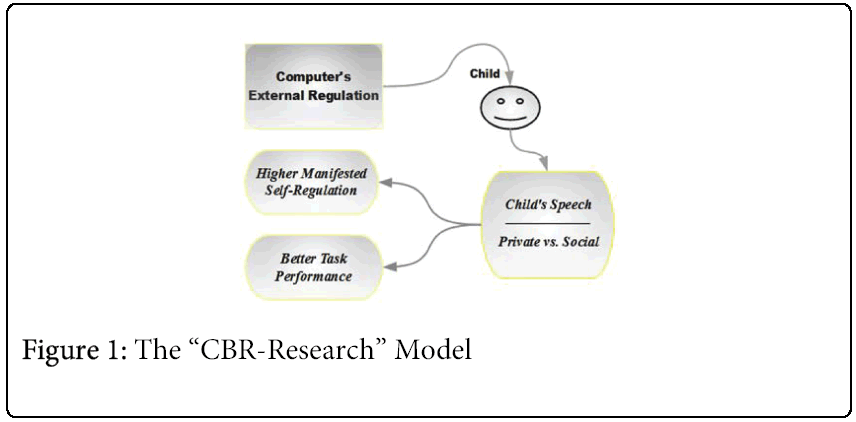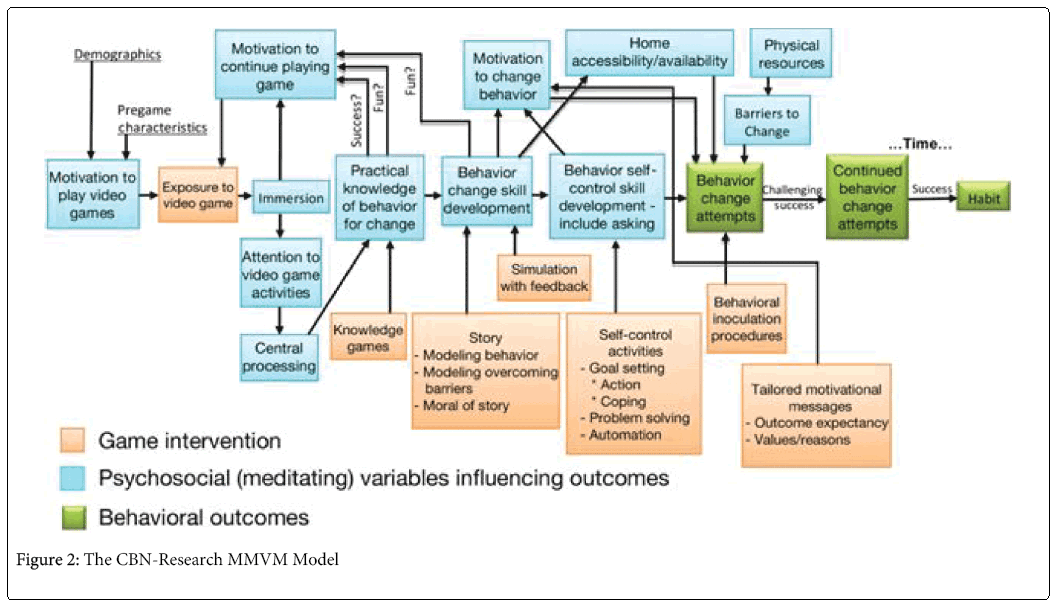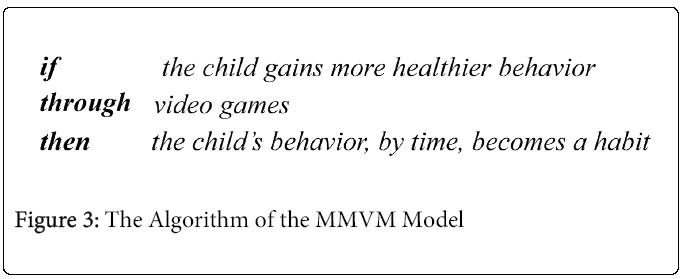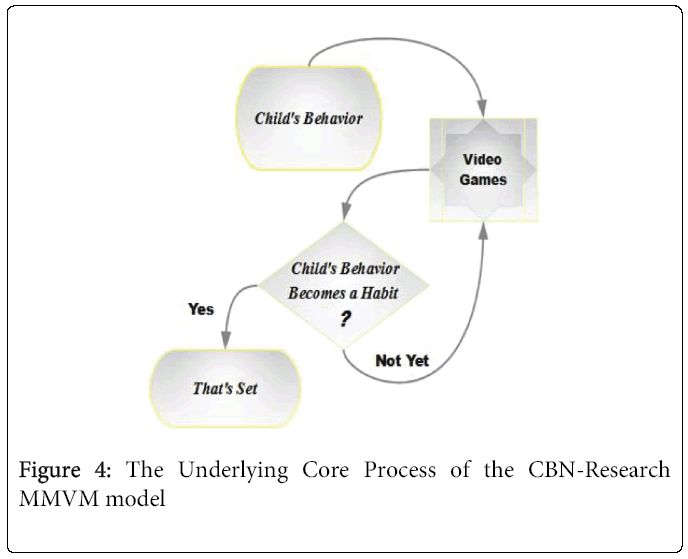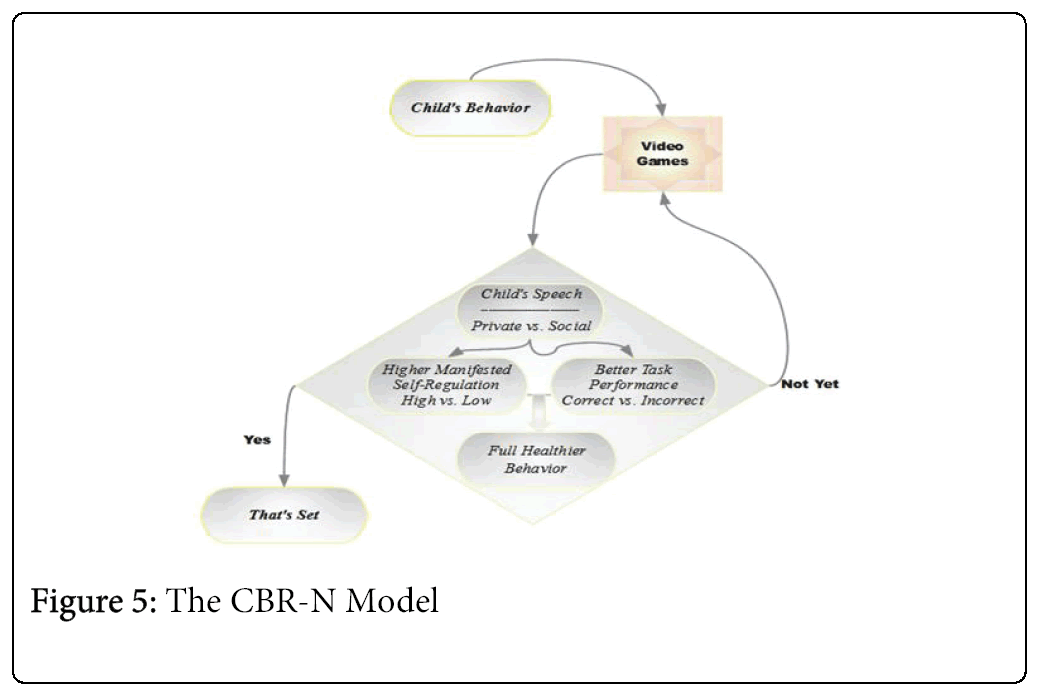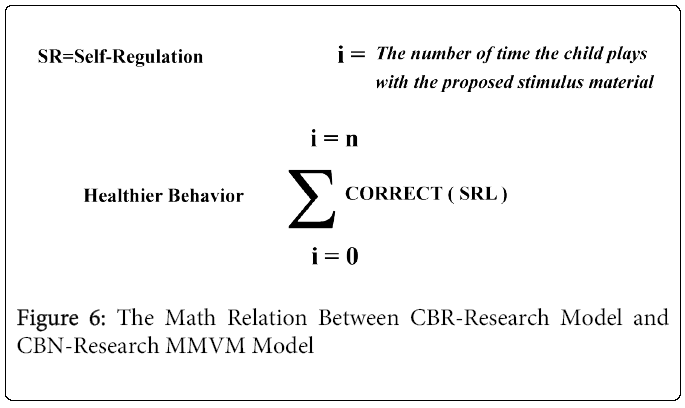Research Article Open Access
An Analytical Reflection towards Understanding the Effect of Children's Behavioral Regulation (CBR) on Children's Behavioral Nutrition (CBN) Through Computer-based Edutainment Environments
Adel M Agina*University of Twente, Human Media Interaction, Enschede, The Netherland
- *Corresponding Author:
- Adel M. Agina
University of Twente, Human Media Interaction
Enschede, The Netherlands
Tel: +218911555810
E-mail: ama@adelagina.net
Received Date: July 01, 2014; Accepted Date: October 13, 2014; Published Date: October 20, 2014
Citation: Agina AM (2014) An Analytical Reflection towards Understanding the Effect of Children's Behavioral Regulation (CBR) on Children's Behavioral Nutrition (CBN) Through Computer-based Edutainment Environments. J Child Adolesc Behav 2:166. doi: 10.4172/2375-4494.1000166
Copyright: © 2014 Adel M. Agina. This is an open-access article distributed under the terms of the Creative Commons Attribution License, which permits unrestricted use, distribution, and reproduction in any medium, provided the original author and source are credited.
Visit for more related articles at Journal of Child and Adolescent Behavior
Abstract
Despite the massive body of research on the effect of media and entertainment on Children's Behavioral Regulation (CBR) and Children's Behavioral Nutrition CBN), especially through computer-based video games, the multidisciplinary research, up to date, still lacks a true understanding of the powerful effect of the communication between users, especially young children, and the content of the entertainment. Remarkably, the relation between CBR and CBN is not comprehensible yet (i.e., still ambiguous) despite many studies investigated the the CBN research came up with the fact that the research on the Innovative Intervention Programs (IIP) are still needed to overcome the limitations in previous programs, and, concluded that serious video games show promise of changing in children's behavior. In sum, the more deeply research is still needed on: (1) the optimal design of behaviorchange procedures in video games, (2) the mechanisms that account for changes obtained, and (3) the groups in which these interventions work best. Such research will permit the optimal design of serious video games for children's better healthier behaviors in the future. On the other hand, creating the IIP in terms of CBR requires many various and different criteria! Thus, the present reflection paper was conducted to, analytically, clarifying the outlines of the current running new multidisciplinary project that mainly investigates the effect of CBR on CBN through computer-based edutainment environments.
Keywords
Children's behavioral regulation (CBR); Children's behavioral nutrition (CBN); Computer-based edutainment; CBRResearch; CBN-Research; CBR-N model; Self-Regulation learning (SRL); Healthier behavior
Introduction
In the literature, especially concerning multidisciplinary researches, many terms and terminologies were injudiciously used insofar the researchers may cognitively overloaded. For instance, the terms “behavior change”, “developmental behavior change”, “children's development change”, “change children's development”, and many others may or may not lead to the same phenomenon unless the use of the associated keywords are judiciously used such as Children's Behavioral Nutrition (CBN) and Children’s Behavioral Regulation(CBR). Remarkably, the literature still lacks the multidisciplinary research that involves CBN and CBR given the fact that the relation between the two is still ambiguous despite many studies investigated the mediating variable analyses with process data on self-regulation (e.g., goal setting and problem and solving). However, those studies did not predict behavior [1,2].
Why The Present Reflection Paper?
The main aim of the present reflection paper is to introduce the outlines of the multidisciplinary research of the current ongoing funded project. This project is basically relying on two different areas of research that involve different views and models. The project aims to investigate the effect of CBR on CBN by gathering the two different views and models.
The first area of the research is relaying on what already introduced in the literature concerning CBR specifically by Agina and his colleagues [3-8]. For the sake of the simplicity and clarity, the current reflection paper refers to the studies by Agina and his colleagues as “CBR-Research”.
The second area of research is relaying on what specifically introduced concerning CBN by Baranowoski et al. [1,2,9-37]. For the sake of the simplicity and clarity, the current reflection paper refers to the studies by Baranowoski and his colleagues as “CBN-Research”.
Children's Behavioral Regulation (CBR): Short Overview
In the literature, each definition and model of Self-regulation learning (SRL) in each area of knowledge is defined and introduced based on the researchers' theoretical background, perspective, and the need of their studies. Therefore, the researchers may also assume their definitions and models in advance or concluded them based on the results of their studies [3]. In philosophy, for instance, the definition is based on self-control, in psychology the definition is based on selfmanagement, in cognitive science the definition is based on selfgenerated, in motivational learning the definition is based on selfmotivation, and recently in computer-gaming the definition is based on self-control [4].
SRL in studies of “CBR-Research” is defined as ''the learners' ability to direct their verbalization process and, simultaneously, monitoring their learning process's goals''. Therefore, SRL is considered as one of the main ingredients of CBR, which refers, as the “CBR-Research” introduced it to “the level of the children's speech use, the differentiation and difference between private speech, social speech, and thinking aloud, and the degree of the children's SRL and satisfaction during learning tasks when children act alone and without any human-human interaction or social intervention before, during, or after the progression”.
The “CBR-Research” Model of Young Children's Behavioral Development
In the studies of the “CBR-Research”, the computer is not only used as a teaching aid but also as an external regulator through special computer-based edutainment tool. The main aim is to enable young children to act alone without distorting their cognitive load either before, during, or after the progression. In other words, the methodology of the experiments in the studies of the CBR-Research is completely relying on the computer, per se, to prevent any humanhuman interaction or social intervention with the young children during learning process. During the progression, the effect of the child's speech (private vs. social) on self-regulation and task performance is investigating through special measurements where the computer, per se, regulates the child to response along the progression time. Figure 1 illustrates the model of the “CBR-Research”.
In terms of CBR, the stimulus material, whatever it is, has to be technically and cognitively designed and implemented by children themselves through engage children as a design-partners. This may cost many and many pilot studies with a number of experiments before implementing the edutainment tool itself.
In terms of designing successful computer-based edutainment, young children have to be engaged as design-partners from scratch to design, generate, and evaluate the stimulus material before using that product in the actual experiments. Otherwise, the motivation will be always needed during learning process to motivate children to keep going, which is undesirable factor in terms of distorting child's thinking process during learning process.
In terms of educational psychology, the child should not get any training on how to use the stimulus material to avoid distorting the children's cognitive overload before running the actual experiment (i.e., the natural process of the child's inner speech will be negatively affected either by the edutainment fashion and/or stylish or socially by the teacher/experimenter who trained the child). Therefore, the stimulus material, per se, has to be smart enough to run such a friendly-chat questionnaire whenever needed but without creating any overloading to the child's current cognitive or thinking processes.
Psychologically, the “fashion and stylish” interface does not mean the product will be definitely accepted by children especially when the gender, just for instance, has conducted as an independent key! Many and many experiments were failed because of the adult-based design as many others failed because of the difference between the game's hero gender and the child.
Cognitively, the stimulus material has to consider the negative effect of the Children's Split Attention (CSA) as well as the Children's Cognitive Overload (CCO) during the progression. Otherwise, there will no chance to separate the verbalization of the child's private speech from social speech and thinking aloud, which are the keys that clarify the content of the children's feeling and thoughts. For instance, the background of the stimulus material during the progression may completely distort the child's thinking process to be cognitively overloaded and the verbalization quality to be mixed between private speech, social speech, and thinking aloud.
Meta-cognitively, thinking aloud is more accurate that children use to describe their feeling and thoughts whereas feeling and thoughts control the child's behavior. Most importantly, child's feeling and thoughts can only be obtained and measured by children's speech and, more accurately, through thinking aloud verbalization that should be spontaneously occurred and without instructing the children to do so, which is the problem that still exist among the researchers so far.
Children's behavioral nutrition (CBN): Short overview
In the studies of “CBN-Research” including many other researchers (e.g., David E. Barrett, a Harvard Medical School psychologist) and many others, the researchers believe that a behavioral healthy diet has long lasting effects on a child’s ability to interact with the others. In specific, children who eat by following a healthier behavioral diet full of nutritious foods is more likely to behave well and better when interacting with others.
In contrast, those children whose healthier behavioral diet is lacking good nutrition is more likely to be antisocial, introverted, and hyperactive and be seen generally to be misbehaved when interacting with the others.
Importantly, it is very essential to have an understanding of how nutrition decisions are an actual healthy decisions. Mostly important question that has to be considered is how young children be able to make the correct decisions, by themselves, to change their unhealthier behaviors to be better and, by time, to be a habit without human's external regulation. This question remains the biggest unanswered question so far.
Equally important, the answer of this big question requires children to regulate themselves, by themselves, through developing standalone edutainment environments. These environment should help children to learn about nutrition and enable them to get the right information they need about having a healthy attitude of the healthy food whenever they need it without seeking help from adults to increase their free-will to follow and build the right behaviors.
The “CBN-Research” Model of Young Children's Behavioral Nutrition
In the studies of the “CBN-Research”, the researchers believe that the CBN can be improved through video games and they introduced their model (Figure 2) named: the Mediating/Moderating Variable.
In terms of programming behavior change, the following algorithm (Figure 3) can be simply concluded as the final outcome from the MMVM model.
To clarify the MMVM model in terms of programming behavior change, a child with an obesity problem, for instance, may change his unhealthier behavior about his “daily dietary list” to follow a new healthy list through such a video game given the fact that play is a nature tendency of all children and the fact that the computer, per se, remains the most interactive and appealing media for people.
In specific, the video game in the MMVM, basically, works to motivate the child to change his unhealthier behavior to become a healthier one. Finally, the child's healthier behavior, by time, becomes a habit so that the child will not return back to that unhealthier behavior. As a result, it can be said that as long as the child uses that video game, his healthier behavior will be improved and, by time, his healthier behavior becomes a habit. Figure 4 shows a simple view of the main underlying process of the CBN-Research MMVM model.
As shown in (Figure 4), the child's habit is clearly an outcome but not an instant or direct result that the child gains after the experiment(s) instantly. In terms of Ontology science, gaining such a behavior to be a habit, by nature, is a function of time. This leads to an associated and sensitive question is that: is the child's behavior a function of time too?!!!!!. Unfortunately, this question remains with no answer in the literature yet.
The Relation between CBR-Research Model and CBNResearch MMVM Model
Children's behavior, generally human, can be changed by time while children's habit cannot (let's say it is nearly impossible to be changed given the fact that habit, mostly, becomes a belief for some people – if not all).
Logically, changing such a behavior at an early age will be easier than in advanced age. Given the CBR-Research definition of selfregulation as “the learners’ ability to direct their verbalization process and, simultaneously, monitoring their learning process’s goals”, the change of such a child's behavior to be a habit needs such a framework between the CBR-Research model and CBN-Research MMVM Model, which is the proposed new model of the current running project as shown in (Figure 5) and named as: CBR-N Model.
Interestingly enough, despite the different area of research of the two models, both of them are mathematically connected to each other as shown in (Figure 6).
Although, the math representation (Figure 6) states the general relationship between the two models, it is clear that the healthier behavior is a function of self-regulation, which is already a function of task performance, which is basically a function of time.
Accordingly, the current running funded project is mainly conducted to investigate the effect of children's self-regulation and task performance on their healthier behavior through computer-based edutainment that will be specifically designed and implemented with young children as design-partners for this project.
The proposed participants
Given the fact that detecting and treating any problem at an early age will be more easier than in advanced age, the proposed participants will be children in different ages but not older than 13 years old (i.e., the aim is to run this project, mainly, with young children at an early age).
The proposed experimental design
The project involves many and several experiments. Each experiment will have a different experimental design with the same or different stimulus material(s). Some experiments will be running at school while others at home. Given the fact that changing children's behavior into a habit is already a function of time, the settings of each experiment, especially concerning the needed time to play, will be different from one experiment to another where each one of them will be effected by the previous one. The proposed experiments will be different in terms of short and long time to play with the proposed stimulus material(s) either at home or school under the supervision of the children's parents and teachers respectively. Depending on the obtained results, new experiments may be added.
The Proposed General Hypothesis and Main Question
The general hypothesis
The more self-regulation the child gains during playing with edutainment video games the more healthier behavior the child gains.
The general main question
To what extent does the children's manifested self-regulation increase children's healthier behavior through computer-based edutainment?
The expected outcomes
The current running project is highly expecting to come up with many and several results/papers in many different and various areas of research such as Computer Games (edutainment), Children's Behavioral Development, Aura Science, Math Analysis of Children's Development, and many other branches of science.
Acknowledgements
The author would strongly like to thank the company of Madinato Attakneia for information technology (MT5IT) for supporting this project along the next coming two years.
References
- Latif H, Watson K, Nguyen N, Thompson D, Baranowski J, et al. (2011) Effects of goal setting on dietary and physical activity changes in the Boy Scout badge projects. Health EducBehav 38: 521-529.
- Cullen KW, Zakeri I, Pryor EW, Baranowski T, Baranowski J, et al. (2004) Goal setting is differentially related to change in fruit, juice, and vegetable consumption among fourth-grade children. Health EducBehav 31: 258-269.
- Agina AM (2008) Towards understanding self-organisation: How self-regulation contributes to self-organisation?. Int. J. Continuing Engineering Education and Life-Long Learning 18: 366-379.
- Agina A M, Kommers PAM (2008) The Positive Effect Of Playing Violent Games On Children’s Self-Regulation Learning. IADIS Multi Conference on Computer Science and Information Systems (MCCSIS 2008) Proceedings. Amsterdam, the Netherlands.
- Agina AM, Kommers PA, Steehouder F (2011a). The effect of the external regulator's absence on children's speech use, manifested self-regulation, and task performance during learning tasks. Computers in Human Behavior 27: 1118-1128.
- Agina AM, Kommers PA, Steehouder F (2011b) The effect of nonhuman's versus human's external regulation on children's speech use, manifested self-regulation, and satisfaction during learning tasks. Computers in Human Behavior 27: 1129-1142.
- Agina A M, Kommers PA, Steehouder F (2011c) The effect of the nonhuman external regulator's answer-until-correct (AUC) versus knowledge-of-result (KR) task feedback on children's behavioral regulation during learning tasks. Computers in Human Behavior 27: 1710-1723.
- Agina AM, Kommers PA, Steehouder F (2011d) The effect of nonhuman's external regulation on detecting the natural development process of young children's self-regulation during learning tasks. Computers in Human Behavior 27: 1724-1739.
- Agina AM, Kommers PA, Steehouder F (2012) The effect of nonhuman’s external regulation on children’s responses to detect children with developmental problems (DP) associated with the natural development of self-regulation during learning tasks. Computers in Human Behavior 28: 527–539.
- Agina A M (2012a) The Effect of Nonhuman's External Regulation on Young Children's Creative Thinking during Learning Mathematical Tasks. Computers in Human Behavior 4: 1213-1226.
- Agina A M (2012b) "Who vs. Whom AND Where Should We Go Through?": A Reflection Towards Clarifying the Effect of Media and Entertainment on Children's Development for Future Research. Computers in Human Behavior 4: 1083-1090.
- Agina AM (2012c) The Effect of Nonhuman's External Regulation on Young Children's Self-Regulation To Regulate Their Own Process of Learning. Computers in Human Behavior 4: 1140-1152.
- Agina AM, Tennyson RD (2012) Towards Understanding the Positive Effect of Playing Violent Video Games on Children’s Development. Procedia - Social and Behavioral Sciences, 69: 780–789.
- Agina AM, Tennyson RD, Kommers PA (2013) Understanding children’s private speech and self-regulation learning in Web 2.0: Updates of Vygotsky through Piaget and future recommendations. In P Ordóñez de Pablos, HO Nigro, RD Tennyson, SEGonzálezCisaro, W. Karwowski (Edn.,) Advancing information management through semantic Web concepts and ontologies. Hershey, PA: IGI Global.
- Baranowski T, Baranowski J, Cullen KW, Marsh T, Islam N, et al. (2003) Squire's Quest! Dietary outcome evaluation of a multimedia game. Am J Prev Med 24: 52-61.
- Baranowski T, Baranowski JC, Cullen KW, Thompson DI, Nicklas T, et al. (2003) The Fun, Food, and Fitness Project (FFFP): the Baylor GEMS pilot study. Ethn Dis 13: S30-39.
- Baranowski T, Cullen KW, Nicklas T, Thompson D, Baranowski J (2003) Are current health behavioral change models helpful in guiding prevention of weight gain efforts? Obes Res 11 Suppl: 23S-43S.
- Baranowski T, Cerin E, Baranowski J (2009) Steps in the design, development and formative evaluation of obesity prevention-related behavior change trials. Int J BehavNutrPhys Act 6: 6.
- Baranowski T, Buday R, Thompson DI, Baranowski J (2008) Playing for real: video games and stories for health-related behavior change. Am J Prev Med 34: 74-82.
- Baranowski T, Watson K, Missaghian M, Broadfoot A, Cullen K, et al. (2008) Social support is a primary influence on home fruit, 100% juice, and vegetable availability. J Am Diet Assoc 108: 1231-1235.
- Baranowski JC, Baranowski T, Beltran A, Watson KB, Jago R, et al. (2010) 6-n-Propylthiouracil sensitivity and obesity status among ethnically diverse children. Public Health Nutr 13: 1587-1592.
- Baranowski T, Watson KB, Bachman C, Baranowski JC, Cullen KW, et al. (2010) Self efficacy for fruit, vegetable and water intakes: Expanded and abbreviated scales from item response modeling analyses. Int J BehavNutrPhys Act 7: 25.
- Baranowski T, Beltran A, Martin S, Watson KB, Islam N, et al. (2010) Tests of the accuracy and speed of categorizing foods into child vs professional categories using two methods of browsing with children. J Am Diet Assoc. 110 :91-94.
- Baranowski T, Baranowski J, Thompson D, Buday R (2011) Behavioral science in video games for children's diet and physical activity change: key research needs. J Diabetes SciTechnol 5: 229-233.
- Baranowski T, Baranowski J, Thompson D, Buday R, Jago R, et al. (2011) Video game play, child diet, and physical activity behavior change a randomized clinical trial. Am J Prev Med 40: 33-38.
- Baranowski T, Baranowski JC, Watson KB, Martin S, Beltran A, et al. (2011) Children's accuracy of portion size estimation using digital food images: effects of interface design and size of image on computer screen. Public Health Nutr 14: 418-425.
- Baranowski T, Abdelsamad D, Baranowski J, O'Connor TM, Thompson D, et al. (2012) Impact of an active video game on healthy children's physical activity. Pediatrics 129: e636-642.
- Baranowski T, Frankel L (2012) Let's get technical! Gaming and technology for weight control and health promotion in children. Child Obes 8: 34-37.
- Baranowski T, Islam N, Baranowski J, Martin S, Beltran A, et al. (2012) Comparison of a Web-based versus traditional diet recall among children. J AcadNutr Diet 112: 527-532.
- Baranowski T, Islam N, Douglass D, Dadabhoy H, Beltran A, et al. (2014) Food Intake Recording Software System, version 4 (FIRSSt4): a self-completed 24-h dietary recall for children. J Hum Nutr Diet 27 Suppl 1: 66-71.
- Baranowski T, Beltran A1, Chen TA1, O'Connor T1, Hughes S1, et al. (2013) Structure of Corrective Feedback for Selection of Ineffective Vegetable Parenting Practices for Use in a Simulation Videogame. Games Health J 2: 29-33.
- Barnett A, Cerin E, Baranowski T (2011) Active video games for youth: a systematic review. J Phys Act Health 8: 724-737.
- Beltran A, O'Connor T, Hughes S, Baranowski J, Nicklas TA, et al. (2012) Alpha Test of a Videogame to Increase Children's Vegetable Consumption. Games Health J 1: 219-222.
- Cerin E, Barnett A, Baranowski T (2009) Testing theories of dietary behavior change in youth using the mediating variable model with intervention programs. J NutrEducBehav 41: 309-318.
- Hingle M, Beltran A, O'Connor T, Thompson D, Baranowski J, et al. (2012) A model of goal directed vegetable parenting practices. Appetite 58: 444-449.
- Lu AS, Baranowski T2, Thompson D2, Buday R3 (2012) Story Immersion of Videogames for Youth Health Promotion: A Review of Literature. Games Health J 1: 199-204.
- Lu AS, Thompson D, Baranowski J, Buday R, Baranowski T (2012) Story Immersion in a Health Videogame for Childhood Obesity Prevention. Games Health J 1: 37-44.
Relevant Topics
- Adolescent Anxiety
- Adult Psychology
- Adult Sexual Behavior
- Anger Management
- Autism
- Behaviour
- Child Anxiety
- Child Health
- Child Mental Health
- Child Psychology
- Children Behavior
- Children Development
- Counselling
- Depression Disorders
- Digital Media Impact
- Eating disorder
- Mental Health Interventions
- Neuroscience
- Obeys Children
- Parental Care
- Risky Behavior
- Social-Emotional Learning (SEL)
- Societal Influence
- Trauma-Informed Care
Recommended Journals
Article Tools
Article Usage
- Total views: 15168
- [From(publication date):
December-2014 - Apr 07, 2025] - Breakdown by view type
- HTML page views : 10461
- PDF downloads : 4707

